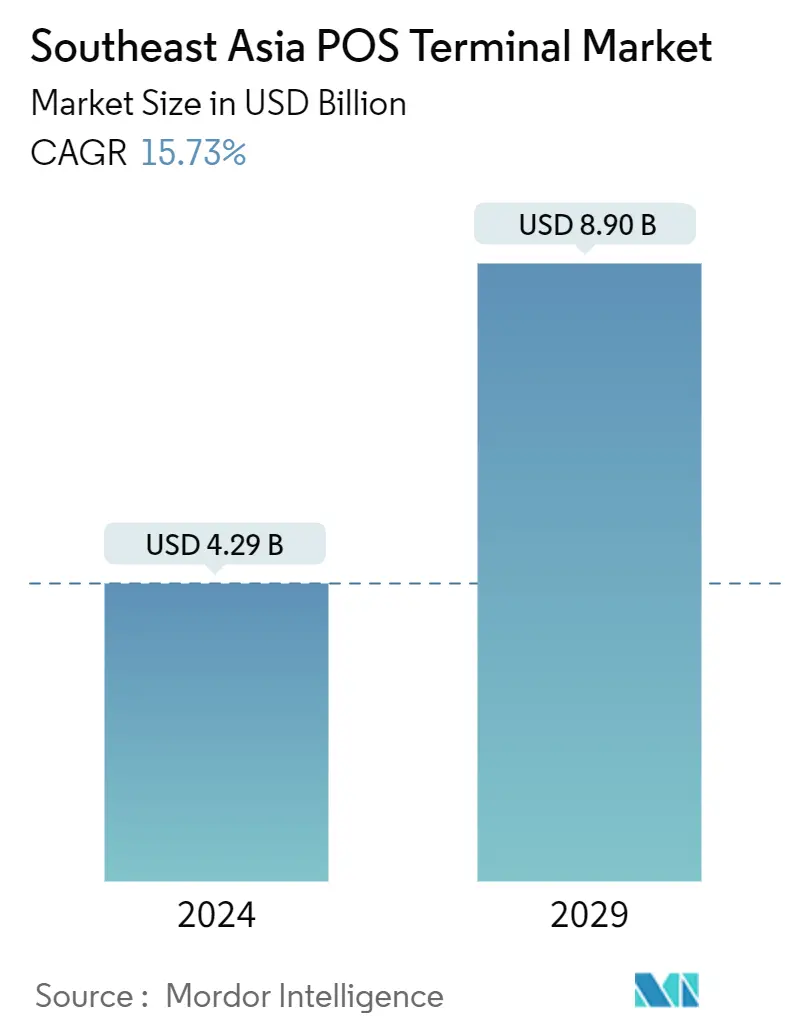Market Size of Southeast Asia POS Terminal Industry

| Study Period | 2019 - 2029 |
| Base Year For Estimation | 2023 |
| Market Size (2024) | USD 4.29 Billion |
| Market Size (2029) | USD 8.90 Billion |
| CAGR (2024 - 2029) | 15.73 % |
| Market Concentration | Medium |
Major Players
*Disclaimer: Major Players sorted in no particular order |
Southeast Asia POS Terminal Market Analysis
The Southeast Asia POS Terminal Market size is estimated at USD 4.29 billion in 2024, and is expected to reach USD 8.90 billion by 2029, growing at a CAGR of 15.73% during the forecast period (2024-2029).
As a result of its ability to deliver an improved return on investment and accessibility, POS terminals have been rapidly adopted over the last few years. Over the years, the importance of point-of-sale systems in small and large enterprises has increased, facilitating transactions from the central part of the enterprise in sectors such as retail, hospitality, transport, and banking.
- POS terminals have evolved from transaction-oriented terminals to systems integrated with the company's CRM and other financial solutions. As a result, end users with business intelligence have better managed their revenue streams and inventory. Companies have replaced their traditional billing software with point-of-sale systems due to the functional benefits of advanced point-of-sale systems to ensure the growth of point-of-sale systems.
- Over the past few years, rising cases of financial crime in Southeast Asia have influenced government regulatory bodies to improve security for payment transactions. The need to use secure payment procedures is becoming increasingly essential to meet consumers' demands for safety and reliability with their digital transactions. These Regulatory Authorities have positively affected the adoption of POS terminals. Mobile POS systems have taken off as a result of rising mobility trends around the world. In the region, POS adoption rates have increased due to the introduction of cashless transaction technologies.
- The growth in terminals and face-to-face outlets is expected to be hampered by the growing e-commerce and online shopping trends and brick-and-mortar retail practices. With the possibility of cash on delivery offered by significant e-commerce platforms, a sudden surge in the adoption of mobile POS terminals was noticed.
- Due to growing customer demand for quick and easy payments, card fraud has become increasingly sophisticated. Hackers may be identified targeting the POS system's firmware to steal credit and other payment data. Point-of-sale fraud is largely caused by merchants' failure to leverage point-to-point encryption (P2PE) solutions to safeguard POS data.
Southeast Asia POS Terminal Industry Segmentation
A POS terminal is a digital terminal that helps businesses complete sales transactions. It helps to store, capture, share, and report data related to sales transactions.
Southeast Asia POS Terminal Market is segmented by component (hardware, software, and services), type (fixed point of sale terminals and mobile/portable point of sale terminals), end-user industries (entertainment, hospitality, healthcare, and retail), and country (Singapore, Indonesia, Vietnam, Malaysia, and other Southeast Asian countries). The market sizes and forecasts are provided in terms of value (USD) for all the above segments.
| By Component | |
| Hardware | |
| Software and Services |
| By Type | |
| Fixed Point-of-Sale Terminals | |
| Mobile/Portable Point-of-Sale Terminals |
| By End-user Industries | |
| Entertainment | |
| Hospitality | |
| Healthcare | |
| Retail | |
| Other End-user Industries |
| By Country | |
| Singapore | |
| Indonesia | |
| Vietnam | |
| Malaysia |
Southeast Asia POS Terminal Market Size Summary
The Southeast Asia POS terminal market is experiencing significant growth, driven by the increasing adoption of advanced point-of-sale systems across various sectors such as retail, hospitality, transport, and banking. These systems have evolved from basic transaction tools to integrated solutions that enhance business intelligence, revenue management, and inventory control. The demand for secure payment procedures has risen due to the growing incidence of financial crime, prompting regulatory bodies to encourage the adoption of POS terminals. The rise of mobile POS systems, fueled by global mobility trends and cashless transaction technologies, has further contributed to the market's expansion. However, the growth of e-commerce and online shopping poses challenges to the traditional face-to-face outlet model, necessitating a reevaluation of business strategies to maintain customer loyalty and competitive advantage.
In Southeast Asia, the digital economy is rapidly expanding, with significant online consumer spending anticipated in the coming years. This growth is driving demand for POS terminals, particularly in the ASEAN big six countries. Singapore, a leader in payment innovation, has made substantial investments in cashless payment infrastructure, with digital wallets gaining popularity. The market is semi-consolidated, with both local and international players vying for market share through strategic partnerships and innovative solutions. Recent developments include the launch of portable POS tools and collaborations to enhance payment security and reduce physical contact. These efforts are part of a broader trend towards promoting alternative payment methods and adapting to changing consumer preferences in the region.
Southeast Asia POS Terminal Market Size - Table of Contents
-
1. MARKET INSIGHTS
-
1.1 Market Overview
-
1.2 Industry Attractiveness - Porter's Five Forces Analysis
-
1.2.1 Bargaining Power of Suppliers
-
1.2.2 Bargaining Power of Consumers
-
1.2.3 Threat of New Entrants
-
1.2.4 Threat of Substitutes
-
1.2.5 Intensity of Competitive Rivalry
-
-
1.3 Assessment of the Impact of COVID-19 on the Market
-
-
2. MARKET SEGMENTATION
-
2.1 By Component
-
2.1.1 Hardware
-
2.1.2 Software and Services
-
-
2.2 By Type
-
2.2.1 Fixed Point-of-Sale Terminals
-
2.2.2 Mobile/Portable Point-of-Sale Terminals
-
-
2.3 By End-user Industries
-
2.3.1 Entertainment
-
2.3.2 Hospitality
-
2.3.3 Healthcare
-
2.3.4 Retail
-
2.3.5 Other End-user Industries
-
-
2.4 By Country
-
2.4.1 Singapore
-
2.4.2 Indonesia
-
2.4.3 Vietnam
-
2.4.4 Malaysia
-
-
Southeast Asia POS Terminal Market Size FAQs
How big is the Southeast Asia POS Terminal Market?
The Southeast Asia POS Terminal Market size is expected to reach USD 4.29 billion in 2024 and grow at a CAGR of 15.73% to reach USD 8.90 billion by 2029.
What is the current Southeast Asia POS Terminal Market size?
In 2024, the Southeast Asia POS Terminal Market size is expected to reach USD 4.29 billion.

